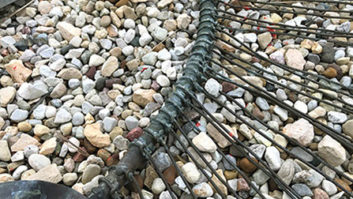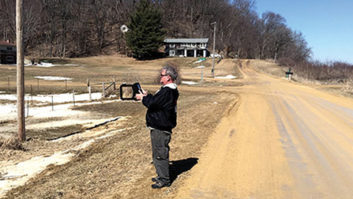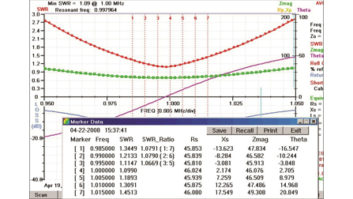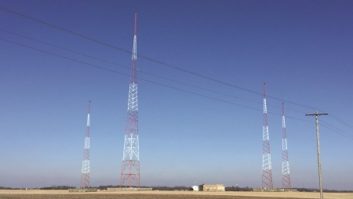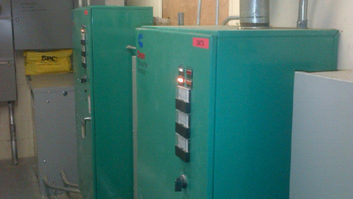Environmental, ground system problems
Mar 1, 2003 12:00 PM, By John Battison, P.E., technical editor, RF
As the FCC continues to delete mandatory measurements and checksfrom the Part 73 rules, some unintentional traps are opened for theunwary engineer. Over the years old-timers have become accustomed tomaking rather comprehensive log entries of such things as basiccurrent, common point current, monitor point measurements and similaroperating parameters. As a result of this, values are checked regularlyand therefore operation should comply with the Commission’srequirements. Should an inspection occur, the odds are that thetransmitting system will be found to be operating in compliance withthe rules. In any case, a comprehensive operating history of thestation is available to successive engineers.

Use a field strength meter to not onlytake monitor point readings, but also to track problems due toreradiation.
On the other hand, many newer engineers may read the revised FCCrules and fail to register the fact that a rule says �must bewithin limits,� or similar words. Sometimes the assumption ismade that the system is operating within limits and regular checks arenot made because they were not man-dated. The end result is that aninspector arrives to find an operating parameter is out and a pinkticket is issued. Or, after several years of normal operation theengineer finds one or more of his operating parameters out of limits.The unfortunate thing is that no one knows when the change occurred,because no one kept a log or even checked the meters on a regularbasis.
Let’s assume that the chief engineer decides to do a monitor pointcheck on a DA system. He finds that one point is way out of limits.When he checks old logs, he finds that this particular point has beengoing out for a long time. This actually occurred on one station whereI was called in, and we found the point had been going out slowly forthree years, but the original proof value had been entered from time totime.
We examined the area of the questionable monitor point anddiscovered that a large pile of rusted iron, mainly consisting of irongirders and iron pipes, had accumulated within several hundred feet ofthe monitor point. A quick trip to the dump area with a field strengthmeter quickly confirmed my suspicions that the high field strengthmeasured at the monitor point was due to the accumulation of thisrather tall pile of iron. It was a relatively easy matter to select anew monitor point and file the necessary paperwork to change location.As a precaution, a skeleton proof was run on this radial and showedthat some points were up slightly, but only the monitor point had beenout of limits.
Detriments to conductivity
Sometimes environmental changes cause field strength to decreasebecause conductivity has changed at the location of the specific point,or between the point and the transmitter. This may be caused by urbanspread as built-up areas intrude over a radial, or maybe by theconstruction of interstate highways, or even large commercial andmanufacturing construction.
The result of all this construction is that large areas of concretewall, paving and similar material extend along the radial between thestation and the monitoring point. Ground conductivity decreases andsignal strength drops.
Cases of reduced monitor point value or lowered radial values thathave constricted and decreased critical coverage contours are muchharder to deal with. The loss of signal strength has probably beencaused by an actual change in conductivity that is beyond the controlof the licensee.
If the problem concerns only a single monitor point, the bestsolution is to pick a new point. If the whole radial is down, there isnot much that can be done, short of moving the transmitter. If a radialis badly damaged due to environmental changes in conductivity, it mightbe possible to augment a DA pattern to increase radiation in thatdirection to restore the original service. This would be an expensiveundertaking and might require a new proof.
Such a situation would be more likely to occur to a long-existingstation. The ground system of a station could be contributing to thereduced field strength due to deterioration. Look at the radials,especially those in the direction of reduced signal strength, as wellas the copper around the base of the tower.

DA field-strength readings may changeduring hot or cold months.
Many stations place a large expanded copper screen around the baseof the tower where the current is highest. Sometimes traffic, diggingand other construction work damages ground systems. Take a fieldstrength meter and walk the ground radials in the reduced fieldstrength direction to see if they are intact and still there. Thecurrent at the end of the radials is usually low. However, if there areno indications of signal in the end sections of the radial it couldindicate radial breaks closer to the tower base.
Avoiding potential problems
I have often wondered if a variation of the sacrificial anodesystem, such as those used on boats, might be useful in protecting aground system. There are different metals, such as iron guy wireanchors and metal ATU Cabinet supports, within the radial system’sregion. A ground system covers an extensive area and the copper wiresmay pass through several regions of different chemical composition.Electrochemical currents could flow and erode sections of copper. Sucha system is available for automobiles as well as boats, and is reputedto work quite well.
Assume there will be a small ground-system resistance loss whencalculating radiated power. Keep in mind that a comparatively smallground system resistance can make a large difference in radiation. Whenmeasuring base operating resistance, include any losses in the groundsystem and also any other losses in the antenna circuit.
If salt or chemicals have been used to improve the groundconnection, renewing the salt or chemicals may solve the problem. Atthe same time the ground electrodes should be examined fordeterioration.
If we have a 5O ground system resistance and an antenna currentof 10A we have 500W of RF dissipated in the ground. If the totalmeasured operating base antenna impedance is only 35O the useful30O would radiate only 3kW of RF. Ground system losses oftenexceed this value, especially in older stations where there has beensubstantial deterioration due to radio damage and copper erosion.
Temperature can also cause misleading and troublesome results. Ihave always felt that it is best to make initial proofs of performancein cold weather. In such weather ground conductivity seems to increase.It is not unusual for a DA that was performing properly during hotsummer months subsequently to become out of tolerance on one or morepoints during winter when the ground is covered in snow.
E-mail Battison at[email protected].





